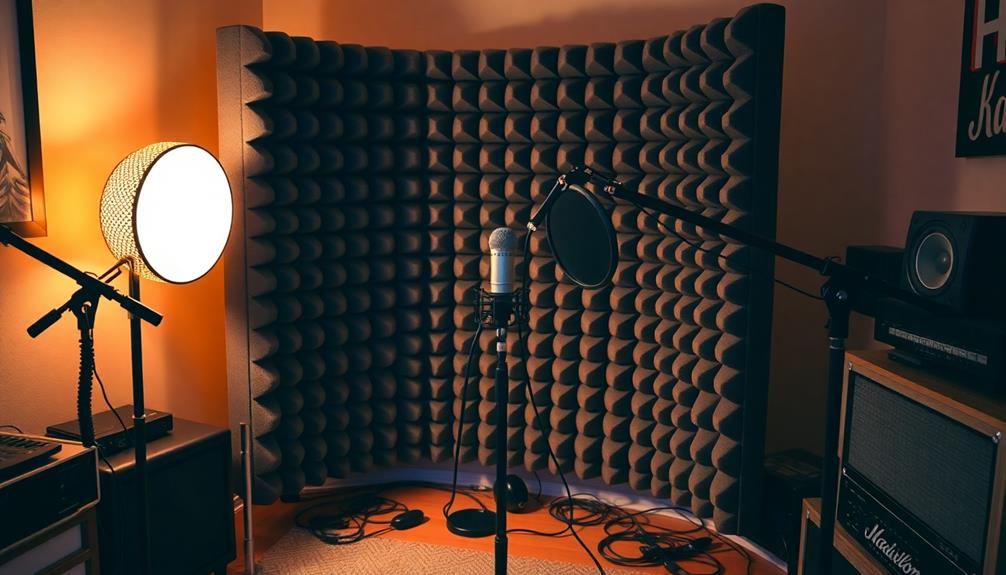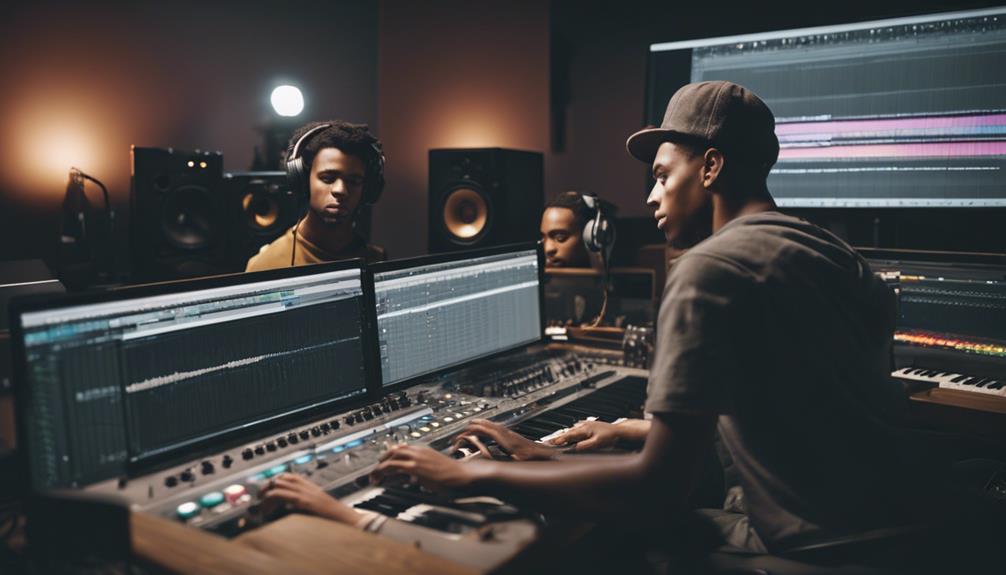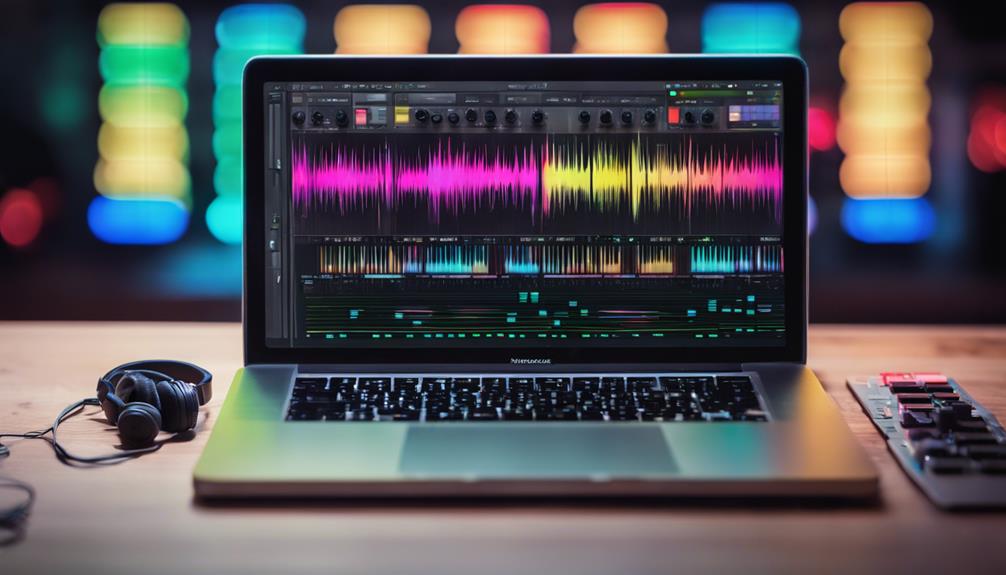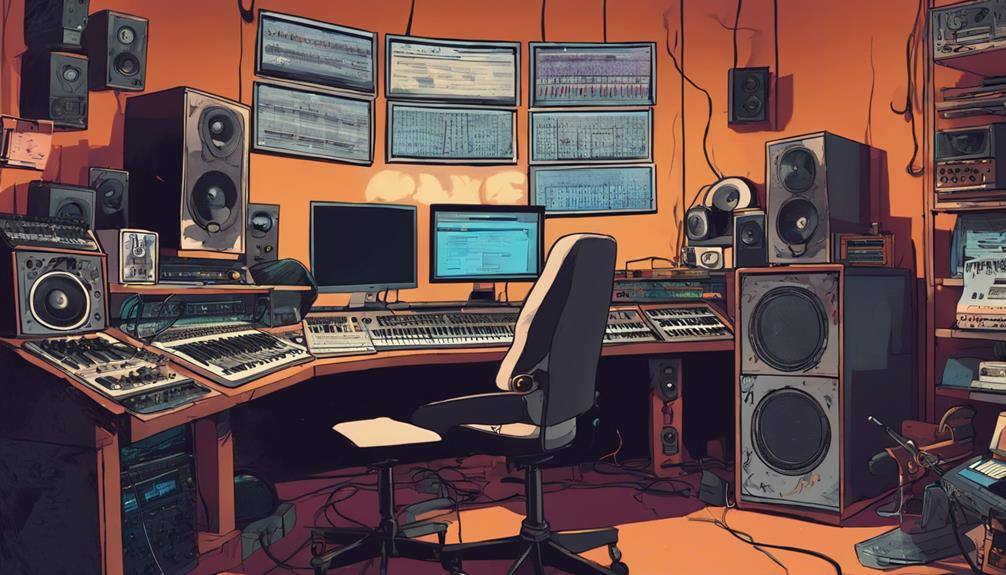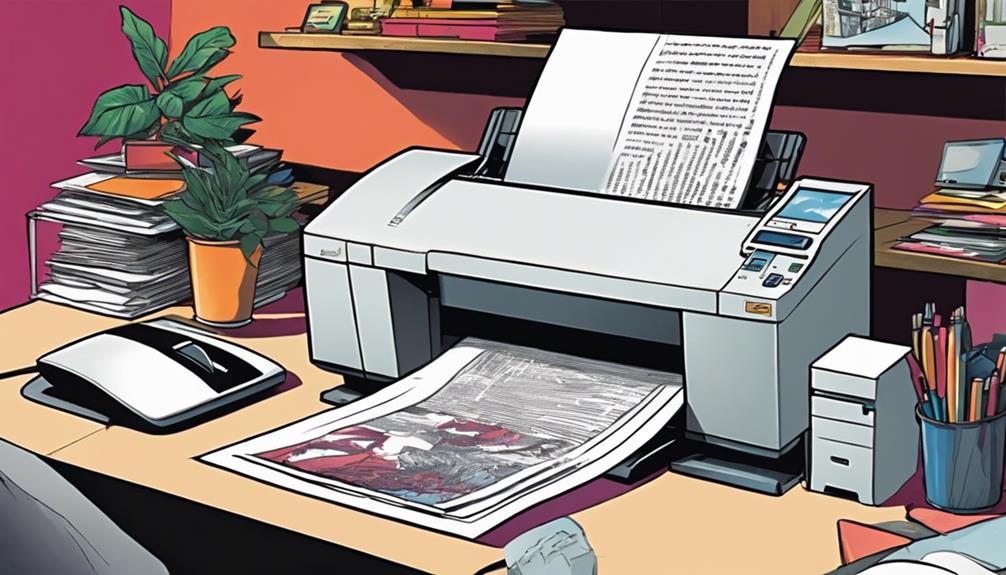I've found 15 fantastic DIY microphone isolation shields under $50 that can truly elevate your recording game. These options feature high-density acoustic foam to reduce echoes and reflections, which is essential for achieving crisp, clear sound. From the compact YOUSHARES Mic Sound Shield to the versatile TONOR Microphone Isolation Shield, you'll discover various designs that are lightweight and portable. Many come with adjustable panels for personalized setup as well. If you're curious about which shields suit your needs best and the specific features they offer, stay tuned for more insights on making the right choice!
Key Takeaways
- DIY microphone isolation shields under $50 effectively reduce echoes and reflections using high-density acoustic foam for improved sound quality.
- Lightweight and portable designs make it easy to transport these isolation shields for use in various recording environments.
- Many options feature adjustable panels, allowing for customizable acoustic performance to suit different microphone setups.
- Compatibility with various microphone types ensures these shields can accommodate both USB and condenser microphones within standard diameters.
- Cost-effective solutions provide high-quality materials and construction, enhancing durability and sound isolation efficiency without breaking the bank.
YOUSHARES Mic Sound Shield Ball for Reducing Echoes and Reflections

If you're a budding podcaster or musician looking to enhance your sound quality without breaking the bank, the YOUSHARES Mic Sound Shield Ball could be your go-to solution. This 8.6-inch diameter acoustic foam ball is designed to reduce echoes and reflections, making your vocals sound clearer. It fits various microphones like the Blue Yeti and HyperX QuadCast, and it even comes with DIY tools for customization. However, the DIY aspect can be tricky—cutting the foam core might leave some users frustrated. While the professional pop filter effectively minimizes plosives, some reviews mention inconsistent shape and missing components. Overall, the YOUSHARES shield has potential, but you might want to weigh the challenges against other pre-assembled options for ease of use.
Best For: Budding podcasters and musicians seeking an affordable solution to enhance sound quality.
Pros:
- Effective sound isolation: Reduces echoes and reflections for clearer vocal recordings.
- Compatible with various microphones: Fits multiple models like Blue Yeti and HyperX QuadCast with customization.
- Portable alternative: Functions like a vocal booth, making it easy to use in different settings.
Cons:
- DIY customization required: Users may find cutting the foam core challenging and frustrating.
- Inconsistent shape reported: Some users have noted the product appears oval instead of spherical.
- Missing components: Complaints about absent pop filter and overall dissatisfaction with performance.
PRO Isolation Shield – Microphone Reflection Filter for Recording

The AUPHONIX PRO Isolation Shield is a game-changer for anyone serious about audio recording, particularly voice-over artists and podcasters. This microphone reflection filter measures 10.4 x 5.7 x 1.4 inches and weighs just 4.44 pounds, making it compact and portable. The high-density acoustic sponge and multi-layered foam effectively reduce outside noise, ensuring crisp sound quality. With two adjustable folding panels, I can customize the setup for ideal insulation. Plus, its durable steel construction means it's built to last. Users rave about the improved recording quality and value for the price, although some mention setup challenges. Overall, I highly recommend this shield for anyone looking to enhance their audio recordings.
Best For: The AUPHONIX PRO Isolation Shield is best for professional voice-over artists, podcasters, and anyone seeking high-quality audio recordings.
Pros:
- Effective sound isolation with high-density acoustic materials for clear audio quality.
- Compact and portable design makes it easy to transport and store.
- Durable construction ensures long-lasting use and stability during recording sessions.
Cons:
- Lack of detailed instructions can lead to setup difficulties for some users.
- Perceived quality issues reported by a few customers, affecting overall satisfaction.
- Setup challenges may arise due to the folding panel mechanism.
Microphone Isolation Shield for Podcast and Studio Recording

Looking for an affordable way to enhance your podcasting or studio recording setup? The Topnaca Microphone Isolation Shield is a fantastic choice. This 5-panel collapsible mic shield features high-density absorbent foam, effectively filtering your vocals while minimizing environmental noise. Measuring 6.3 x 6.69 x 11.81 inches and weighing just 2.79 pounds, it's compact and portable, making it easy to set up on your desk or mount on a microphone stand.
The triple sound-proofing technology guarantees clear sound quality, and I appreciate how adjustable the panels are for peak acoustic performance. While some users reported durability issues, many praised its effectiveness for reducing ambient noise. Overall, it's a solid option for anyone looking to improve their recording quality on a budget.
Best For: Podcasters and studio recording enthusiasts looking for an effective and affordable solution to improve sound quality.
Pros:
- High-density foam effectively reduces ambient noise for clearer recordings.
- Adjustable panels allow for customizable acoustic configurations.
- Compact and portable design makes it easy to set up and store.
Cons:
- Some users reported durability issues with parts breaking during assembly.
- The weight may be cumbersome for certain microphone setups.
- Limited customer ratings indicate mixed experiences with overall performance.
Professional Microphone Isolation Ball with Pop Filter

For anyone seeking an affordable yet effective solution to enhance their recording quality, the Professional Microphone Isolation Ball with Pop Filter stands out as a top choice. This innovative product features a two-layered pop filter and high-density foam, ensuring excellent noise cancellation while being compatible with popular microphones like the Audio-Technica AT2035 and Blue Yeti. It minimizes unwanted sounds—like plosives and breath noises—while protecting your mic from saliva and accidental drops. Weighing only 120 g, it's lightweight and easy to mount, making it perfect for personal recordings, professional studios, or outdoor gigs. Users rave about the noticeable improvement in vocal clarity, though some suggest additional sound shields for the best results. Overall, it's a great compact alternative to traditional vocal booths.
Best For: The Professional Microphone Isolation Ball with Pop Filter is best for podcasters, musicians, and content creators looking for an affordable solution to improve their recording quality in various environments.
Pros:
- Effective noise cancellation reduces unwanted sounds like plosives and breath noises.
- Lightweight and portable design makes it easy to mount and suitable for various recording settings.
- Durable construction with high-density foam ensures longevity and maintains shape over time.
Cons:
- Some users may find it insufficient for extreme noise control and recommend additional sound shields.
- Compatibility limitations could affect users with microphones outside the listed models.
- Potential for mixed results depending on the specific recording environment and setup.
Professional Microphone Isolation Ball Shield for Studio Quality Recording

Designed with audio enthusiasts in mind, a Professional Microphone Isolation Ball Shield offers exceptional noise reduction and studio-quality recording capabilities. This shield effectively minimizes unwanted noise, improving your audio clarity considerably—one user even noted a drop in noise floor by -8dB! It's compatible with most USB and condenser microphones, fitting snugly on models 40-70mm in diameter. The design is lightweight and durable, making it easy to transport and set up wherever you record. While some may find its look bulky, I believe it adds a unique touch to my studio. Just remember, it won't replace a soundproofed studio but is an excellent addition for enhancing your recordings, whether for voiceovers, podcasts, or singing.
Best For: Audio enthusiasts and content creators seeking to enhance their recording quality with improved noise reduction.
Pros:
- High-quality noise reduction effectively minimizes unwanted sounds, resulting in clearer recordings.
- Versatile compatibility with a range of microphone types, making it suitable for various recording setups.
- Lightweight and durable design allows for easy transport and installation in different environments.
Cons:
- Some users may find the bulkiness of the shield visually unappealing in a recording setup.
- Not a substitute for a fully soundproofed studio, limiting its effectiveness in untreated spaces.
- Requires adequate space below the microphone's mouthpiece, which may not suit all setups.
Moukey Microphone Isolation Shield for Recording Studio

The Moukey Microphone Isolation Shield stands out as an excellent choice for aspiring podcasters and home studio enthusiasts seeking professional sound quality on a budget. This shield features reflective, filter, and absorbing layers, with high-density acoustic foam that effectively eliminates audio wave bounces, ensuring clean recordings. I love how easy it is to set up—just unfold it on my desk or mount it on a microphone stand, thanks to the included conversion nuts.
The durable ABS construction feels solid, and I've noticed a significant improvement in sound quality and noise reduction. It's adjustable too, allowing me to find the perfect angle for ideal insulation. Overall, I'd highly recommend the Moukey shield for anyone looking to enhance their recording experience without breaking the bank.
Best For: Aspiring podcasters and home studio enthusiasts seeking professional sound quality on a budget.
Pros:
- High-density acoustic foam effectively eliminates audio wave bounces for clean recordings.
- Durable ABS construction ensures long-lasting performance and stability during use.
- Adjustable design allows for optimal angle adjustments to enhance sound insulation.
Cons:
- Some users report challenges with top-mounted microphones due to design limitations.
- Mixed feedback on reverb reduction effectiveness, with some noting minimal impact.
- Limited portability despite being foldable, as it may require additional space during setup.
LZSIG Microphone Isolation Shield (XL)

If you're a podcaster or home studio enthusiast looking to enhance your recordings without breaking the bank, the LZSIG Microphone Isolation Shield (XL) stands out with its impressive sound isolation capabilities. This foldable mic shield features five adjustable panels, making it easy to store and transport. The arched design effectively blocks unwanted noise, thanks to its three-layer construction that includes high-density acoustic foam. I love how flexible it is; you can quickly adjust the angles with just a knob twist. Plus, it comes with adapters for various microphone stands, ensuring compatibility. Users rave about its sound clarity and portability, although some might find it a bit low for standing singers. Overall, it's a solid choice for quality recordings on a budget.
Best For: Podcasters and home studio enthusiasts seeking an affordable solution for sound isolation and improved audio clarity. This product is designed to minimize unwanted echoes and enhance vocal quality, making it ideal for recording in smaller, less acoustically optimized spaces. As one of the best budget acoustic treatment solutions available, it offers an excellent balance of performance and affordability without compromising on sound integrity. Whether you’re recording a podcast, voiceover, or music, this is a reliable choice for achieving professional results on a budget.
Pros:
- Effective sound isolation with a three-layer construction and high-density acoustic foam.
- Portable and foldable design allows for easy transport and storage.
- Tool-free adjustments enable quick setup and customization for various recording setups.
Cons:
- Might be too low for standing singers, affecting recording comfort.
- Some users have reported an awkward mic-holder design.
- Limited height adjustments may not suit all recording environments.
Frgyee Microphone Isolation Shield with Mic Stand and Pop Filter

For those just starting out in home recording, the Frgyee Microphone Isolation Shield with Mic Stand and Pop Filter stands out as an excellent choice under $50. This setup features high-density absorbent foam that considerably reduces sound reflection, enhancing the clarity of your recordings. I love its portable and foldable design, which makes it easy to adjust angles and transport. The adjustable pop filter effectively minimizes plosive noise, ensuring cleaner audio. While it has a durable steel mic stand with 360° rotation, some users report instability when fully extended. Overall, despite a few complaints about build quality, the Frgyee offers a great balance of performance and affordability for beginners enthusiastic to improve their sound quality.
Best For: Beginners in home recording looking for an affordable and portable microphone isolation solution.
Pros:
- High-density absorbent foam effectively reduces sound reflection for clearer recordings.
- Portable and foldable design allows for easy transport and angle adjustments.
- Adjustable dual-layer pop filter minimizes plosive noise and wind interference.
Cons:
- Reports of instability with the mic stand, especially when fully extended.
- Pop filter clamp may loosen during use, affecting performance.
- Some users have experienced incomplete products or missing parts upon delivery.
Audiosoul Professional Recording Microphone Isolation Shield

Looking for a reliable solution to improve your vocal recordings? The Audiosoul Professional Recording Microphone Isolation Shield has got you covered. Its high-density acoustic foam effectively absorbs sound waves, minimizing unwanted noise and echoes for crystal-clear audio. I love its adjustable and foldable design, making it easy to set up in any space, whether at home or on the go. Weighing just 9.02 pounds, it's lightweight and portable, fitting perfectly on a desktop or mounting on a mic stand. Plus, its sleek appearance adds a touch of professionalism to my recording setup. With a solid rating of 4.4 stars, this shield proves to be a durable and reliable choice for anyone serious about sound quality.
Best For: The Audiosoul Professional Recording Microphone Isolation Shield is best for musicians, podcasters, and voice actors seeking to enhance their audio recording quality in any environment.
Pros:
- High-density acoustic foam effectively absorbs sound waves, reducing noise and echoes.
- Adjustable and foldable design allows for versatility and easy setup in various locations.
- Lightweight construction makes it portable and convenient for on-the-go recording.
Cons:
- May require additional setup space depending on the recording environment.
- Limited size might not accommodate larger microphones or setups.
- Price point could be a consideration for budget-conscious users.
Professional Microphone Isolation Shield with Pop Filter for Recording

The Professional Microphone Isolation Shield with Pop Filter is perfect for anyone enthusiastic to enhance their recording quality without breaking the bank. This compact shield, measuring 8.43 x 7.52 x 6.97 inches and weighing only 200 grams, fits microphones with a diameter of 40mm-60mm. It effectively reduces audio wave bounce and unwanted noise, thanks to its high-density sound-absorbing foam. I love how the dual-layer pop filter minimizes hissing and plosive sounds, ensuring my recordings stay crisp and clear. Plus, its lightweight design makes it easy to transport, and it mounts effortlessly on various mic stands. With a 4.6-star rating from 188 reviews, it's clear that this shield is a favorite among fellow audio enthusiasts.
Best For: Recording enthusiasts, podcasters, and musicians looking for an affordable solution to improve sound quality.
Pros:
- High-density sound-absorbing foam effectively reduces unwanted noise and improves clarity.
- Lightweight and portable design makes it easy to transport and set up in various locations.
- Dual-layer pop filter minimizes hissing and plosive sounds without compromising sound quality.
Cons:
- Microphone and holder not included, requiring additional purchases for full setup.
- Limited compatibility with microphones outside the 40mm-60mm diameter range.
- May require adjustments for optimal placement on different mic stands, which could be inconvenient for some users.
Microphone Isolation Shield with Pop Filter

A microphone isolation shield with a pop filter is an excellent choice for budding podcasters and home studio enthusiasts seeking to improve their sound quality without breaking the bank. This versatile shield features a five-fold foldable design, making it perfect for Blue Yeti and other condenser microphones. With triple sound insulation technology, it effectively absorbs, filters, and reflects sound, while high-density acoustic foam minimizes unwanted background noise.
The sleek design and robust build guarantee durability, and it's portable enough for mobile recording setups. Setting it up is straightforward, thanks to the adjustable tripod stand. Users rave about its performance, noting cleaner vocals and reduced room reflections, making it a fantastic investment at just $35.
Best For: Budding podcasters and home studio enthusiasts looking to enhance sound quality affordably.
Pros:
- Effective sound insulation: Features triple sound insulation technology that absorbs, filters, and reflects sound.
- Portable design: Easily transportable with a foldable structure, ideal for mobile recording setups.
- User-friendly setup: Comes with an adjustable tripod stand for simple installation and customization.
Cons:
- Foam shape issues: Some users reported crushed foam upon arrival, which may take time to regain its shape.
- Confusing tripod assembly: Instructions for assembling the tripod can be unclear, leading to user frustration.
- Limited application: Not recommended for on-camera or multi-person recordings, which may limit its versatility.
Microphone Windscreen Pop Filter for Large Mic

For those using large condenser microphones, the Microphone Windscreen Pop Filter stands out as an essential tool in achieving professional sound quality without breaking the bank. Made from high-density noise-canceling sponge, it effectively filters ambient noise, allowing your voice to shine through while reducing unwanted echoes. Weighing only 200g, it's lightweight and portable, making it perfect for recording on the go. This pop filter fits most condenser microphones with a diameter of 40mm-60mm, making it versatile for various applications like podcasting, live streaming, and studio recording. Setting it up is a breeze—just insert your mic, attach the filter, and you're ready to record. Plus, the included mic stand and phone holder enhance convenience, ensuring you get the best sound possible.
Best For: This product is best for podcasters, musicians, and content creators seeking to enhance their recording quality with a budget-friendly solution.
Pros:
- Cost-effective solution for achieving professional sound quality.
- Lightweight and portable, making it easy to transport for recordings anywhere.
- Easy setup process allows for quick and hassle-free installation.
Cons:
- May not completely eliminate all background noise, particularly in noisy environments.
- Limited compatibility with microphones outside the 40mm-60mm diameter range.
- Some users report it may not fully reduce echoes in multipurpose rooms.
CAHAYA Microphone Isolation Shield

Designed with portability in mind, the CAHAYA Microphone Isolation Shield is perfect for anyone seeking a budget-friendly solution to improve their recording quality. Its foldable design features five panels that allow me to adjust angles for ideal sound absorption and noise reduction. The combination of a reflective layer, filtering layer, and thickened soundproof foam effectively minimizes echo and reverb, making my recordings much clearer.
Installation is a breeze, as it's compatible with most microphone stands, thanks to the included adapter. Weighing just 2.44 pounds, it's easy to transport and store. With a solid customer rating of 4.2 out of 5 stars, I highly recommend this shield for home studios or anyone looking to enhance their audio quality without breaking the bank.
Best For: Those seeking an affordable solution to enhance audio quality in home studios or on-the-go recording setups.
Pros:
- Effective noise reduction with a combination of reflective and soundproof layers.
- Lightweight and portable design, making it easy to transport and store.
- User-friendly installation compatible with most mic stands, ideal for beginners.
Cons:
- Limited sound isolation in extremely noisy environments.
- Panels may require adjustment for optimal performance, which can be time-consuming.
- Not suitable for larger studio setups due to its compact size and design limitations.
TONOR Microphone Isolation Shield for Condenser Microphones

If you're a budding podcaster or musician seeking to enhance your audio quality, the TONOR Microphone Isolation Shield is a fantastic option under $50. This three-panel design, made from alloy steel and high-density foam, effectively reduces noise reflection and interference, making it perfect for vocal and acoustic recording. At 8.3 inches tall and 13 inches wide, it's compact and lightweight, easily fitting on a desk or being mounted to a mic stand. Users love its performance, often noting significant improvements in sound quality. However, I've heard some mention minor compatibility issues with certain stands. Overall, despite some installation quirks, the TONOR shield offers excellent value for elevating your recording experience!
Best For: The TONOR Microphone Isolation Shield is best for podcasters and musicians looking to improve their audio quality in home studios or professional settings.
Pros:
- Effectively reduces noise reflection and interference, enhancing sound quality.
- Compact and lightweight design allows for easy transport and setup.
- Versatile three-panel design offers flexibility in positioning.
Cons:
- Some users report compatibility issues with certain microphone stands.
- Size may be smaller than expected, affecting its effectiveness in larger spaces.
- Installation instructions could be clearer, leading to potential setup challenges.
Microphone Isolation Ball Shield for Studio Quality Recording

Recording high-quality audio without breaking the bank is a dream for many aspiring musicians and podcasters, and the Microphone Isolation Ball Shield is just what you need. This versatile shield offers effective noise reduction, ensuring your recordings are clear and professional. It fits most USB and condenser microphones with a detachable jacket that accommodates diameters of 40-70mm.
I love its sturdy yet lightweight design, making it easy to transport and set up on desktops, tripods, or floor stands. The shield also protects my microphone from corrosion and accidental damage, extending its lifespan. If you're aiming for studio-quality sound without overspending, this isolation ball shield is a game-changer for your recording setup.
Best For: Aspiring musicians, podcasters, and content creators seeking high-quality audio recording without a hefty investment.
Pros:
- Effective noise reduction enhances recording clarity and professionalism.
- Lightweight and portable design allows for easy transportation and setup.
- Protects microphones from damage and corrosion, ensuring longevity.
Cons:
- Limited compatibility with microphones outside the 40-70mm diameter range.
- May require additional equipment for optimal placement and setup.
- Performance may vary based on the recording environment and background noise levels.
Factors to Consider When Choosing a DIY Microphone Isolation Shield Under

When I'm choosing a DIY microphone isolation shield under $50, I focus on a few key factors. Cost-effectiveness and material quality are essential for ensuring I get good value without compromising durability. I also consider how easy it is to assemble and how well it isolates sound, plus whether it's compatible with my microphone setup.
Cost-Effectiveness and Value
Cost-effectiveness is a top priority for anyone looking to create a DIY microphone isolation shield under $50. I've found that many options in this price range deliver impressive sound isolation without forcing you to invest in costly professional equipment. A well-constructed DIY shield can markedly enhance audio quality by minimizing unwanted noise and echoes, which makes your investment even more valuable.
When I choose a budget-friendly option, I always consider the durability of materials. High-density foam and sturdy frames can offer better long-term performance, reducing the need for replacements as time goes by. Plus, many DIY shields allow for customization, letting you tailor the design to fit your specific recording environment. This adaptability can lead to superior sound treatment at a fraction of the cost of professional solutions.
Ultimately, evaluating overall value goes beyond just the price tag. It's essential to assess how effective the shield is in achieving that professional sound quality. For audio enthusiasts like me on a budget, finding a balance between cost, effectiveness, and customization makes all the difference in creating crisp, clear sound without breaking the bank.
Material Quality and Durability
Choosing the right materials for a DIY microphone isolation shield can greatly enhance its performance and lifespan. One of the first things I look for is high-density acoustic foam, which is fundamental for effective sound absorption. It not only improves the quality of my recordings but also guarantees the shield lasts longer. I also prefer shields made from rugged ABS plastic or premium steel, as these materials provide excellent structural integrity. They can endure frequent use without compromising performance.
A sturdy frame and reinforced connections are significant features; they prevent wear and tear during transport and setup. If I'm moving my setup often, I opt for lightweight yet durable designs. These make it easier to set up or break down without risking damage to the shield.
Lastly, I pay attention to the thickness of the foam layer. Thicker foam offers better noise reduction and retains its shape over time, which is essential for maintaining the shield's overall effectiveness. By focusing on material quality and durability, I guarantee my DIY microphone isolation shield not only performs well but also stands the test of time.
Ease of Assembly
A smooth assembly process is vital for a successful DIY microphone isolation shield under $50. Many of these shields require you to cut and customize foam for a favorable fit, which can be confusing if you expect a pre-assembled product. That's why understanding the assembly process is important. Some designs even come with tools like utility knives for foam adjustments, which can be helpful but might also add to the complexity.
I've found that clear instructions greatly enhance the user experience. When products lack detailed setup guidance, it can lead to difficulties and frustration during assembly. Thus, it's smart to look for shields that offer thorough instructions.
Portability is another aspect to evaluate. Foldable designs not only make it easier to adjust angles but also allow you to collapse the shield for convenient transport and storage. Finally, user feedback often emphasizes the importance of ensuring all necessary components are included in the package. Nobody wants to deal with an incomplete setup when you're excited to start recording. Choosing a shield that prioritizes ease of assembly will save you time and headaches in the long run.
Sound Isolation Efficiency
When selecting a DIY microphone isolation shield under $50, sound isolation efficiency is something I always consider. The materials used play an essential role; I prefer high-density acoustic foam since it absorbs sound waves better than standard foam. This choice minimizes reflections and creates a clearer recording.
Next, I look at the design of the shield. Shields with more panels and adjustable angles allow for better customization, which is important for ideal acoustic performance. I've noticed that those with multiple layers—absorbing, filtering, and reflective materials—offer superior sound isolation. They tackle different frequencies, which helps reduce noise interference.
Size matters too. A larger shield can envelop the microphone, effectively minimizing ambient noise and echoes from the surroundings. I also make sure that the shield is compatible with various microphone stands for proper installation. Stability and positioning are critical, as they greatly influence the shield's ability to reduce unwanted sound reflections. Overall, by focusing on these factors, I can guarantee that my DIY microphone isolation shield delivers the crisp, clear sound I'm aiming for.
Compatibility With Microphones
Ensuring compatibility with your microphones is vital for getting the best performance from a DIY microphone isolation shield. When I'm choosing one, I always look for options that feature a detachable jacket to accommodate a range of microphone diameters, typically between 40mm and 70mm. This versatility means I won't be limited to just one type of microphone.
I also check if the isolation shield is designed to fit popular microphone models, especially those that are industry standards like USB and condenser microphones. It's important to verify that the mounting options align with my microphone stand's specifications, focusing on common screw sizes like 3/8 and 5/8 inches.
Additionally, I consider the weight and build quality of the shield. A sturdy design not only supports my microphone but also maintains stability during use. Finally, I always assess user reviews to identify any reported compatibility issues with specific microphone models or mounting hardware. This step saves me time and money by ensuring I choose a shield that truly meets my needs. By keeping these factors in mind, I can confidently select a DIY isolation shield that enhances my recording quality.
Portability and Storage
In today's fast-paced recording environment, portability and storage are key factors I consider when choosing a DIY microphone isolation shield under $50. I often find myself recording in different locations, so a lightweight design is essential. Many affordable options weigh less than 3 pounds, making it easy to transport them without hassle.
I also appreciate shields with foldable designs or those that can be disassembled. These features save valuable space, especially if I have limited storage capacity at home. A compact shield that collapses allows me to tuck it away neatly when not in use.
Another aspect I look for is adjustable panels. They enable me to customize angles, making it easier to adapt to various recording environments. This flexibility enhances portability, ensuring I can get the best sound in any setting.
Lastly, I consider included mounting options. Shields that are compatible with standard microphone stands streamline setup and storage. This efficiency means I can focus on my recording, knowing my gear is easy to manage. With these factors in mind, I can find a DIY microphone isolation shield that suits my needs perfectly.
Design and Aesthetics
Choosing the right DIY microphone isolation shield goes beyond just functionality; the design and aesthetics play a significant role too. When I'm looking for a shield, I pay attention to its structure. Many feature multiple panels or layers, combining reflective and absorbent materials that enhance sound isolation. This design not only improves audio quality but also adds a professional touch to my setup.
Aesthetically, I've noticed a variety of styles available, from sleek, modern looks to more utilitarian designs. I prefer options that align with my personal taste or the overall vibe of my studio. Color is another factor; I usually opt for black or neutral tones, as they blend seamlessly into my recording environment and reduce visual distractions.
Construction quality is essential, too. Durable materials bolster sound isolation and contribute to a polished appearance. Finally, I appreciate designs that prioritize portability and compactness. Having a shield that's easy to store and transport without sacrificing functionality is a definite plus. Balancing these design elements with practicality guarantees I get the most out of my DIY microphone isolation shield.
Frequently Asked Questions
How Do I Properly Set up My Microphone Isolation Shield?
I set up my microphone isolation shield by positioning it around the mic, ensuring it's stable and at the right height. I check for any gaps and adjust the angle to minimize reflections and background noise.
Can I Use a Microphone Isolation Shield for Live Performances?
Using a microphone isolation shield for live performances is like having a superhero protect your sound. It helps reduce background noise, ensuring your voice shines through, even in the loudest environments. Trust me, it's worth it!
What Materials Are Best for DIY Microphone Isolation Shields?
I've found that dense foam, cardboard, and wood work best for DIY microphone isolation shields. These materials effectively reduce unwanted noise and reflections, helping me achieve clearer sound quality during recordings or performances.
How Do I Maintain My Microphone Isolation Shield?
I've found maintaining my microphone isolation shield isn't as tricky as it seems. Regularly dusting it and checking for wear keeps it in shape, ensuring I capture the best sound quality every time I record.
Will a Microphone Isolation Shield Improve Sound Quality in a Noisy Environment?
I've found that a microphone isolation shield definitely improves sound quality in noisy environments. It reduces unwanted background noise, helping me achieve clearer recordings. So, if you're recording, it's worth considering one for your setup!
Conclusion
In the world of recording, achieving that crystal-clear sound isn't just a dream—it's within your grasp. With these 15 DIY microphone isolation shields under $50, you can transform your home studio into a professional haven, where echoes fade away like whispers in the wind. So, whether you're podcasting or laying down tracks, don't let unwanted noise steal your thunder. Grab one of these affordable options, and let your voice shine like never before.

